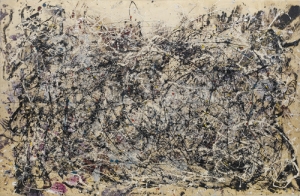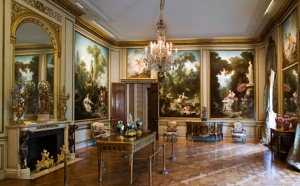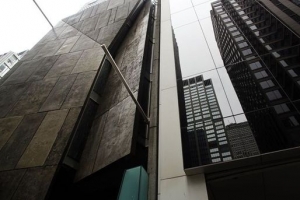|
Displaying items by tag: Museum of Modern Art

On June 10, 2013, Bank of America announced the recipients of its 2013 Art Conservation Project. The program provides grant funding to international nonprofit museums to conserve historically and culturally significant works of art that are in danger of deterioration.
This year, Bank of America’s Art Conservation Project will provide funding for 24 works in 16 countries. One of the most significant undertakings is the restoration of Simon Rodia’s Watts Towers in Los Angeles. Built between 1921 and 1953, the Watts Towers are an iconic part of the city and have fallen into disrepair. The towers are part of the Los Angeles County Museum of Art. Other projects include the restoration of Jackson Pollock’s (1912-1956) Number 1A, One, and Echo at the Museum of Modern Art; 13 mural drawings by Diego Rivera (1886-1957) at the Detroit Institute of Arts; four Tudor paintings at the National Portrait Gallery in London; a Rembrandt (1606-1669) study at the National Gallery in Prague; and a Frida Kahlo (1907-1954) photography collection at La Casa Azul in Mexico.
Bank of America launched its Art Conservation Project in Europe, the Middle East, and Africa in 2010. It was expanded to include the Americas, Asia, and Australia in 2012. Including this year’s recipients, Bank of America will have funded the conservation of 57 projects in 25 countries.

After a 10-month-long restoration, New York’s Museum of Modern Art has rehung Jackson Pollock’s (1912-1956) One – Number 31, 1950. The painting, which is considered one of the most significant works from the Abstract Expressionist movement, is also one of the finest examples of Pollock’s iconic drip paintings.
The restoration process, which began last July, involved feather dusting the canvas and the removal of decades of dirt that had left the painting with a yellow tinge. MoMA’s conservators used sponges, moist erasers, and cotton swabs to gently cleanse the massive canvas, which measures 9 feet high by 17 ½ feet wide. In addition to the cleaning, conservators closely studied the painting using X-ray and ultraviolet lights.
After thorough analysis of the canvas, conservators discovered that certain portions of One – Number 31, 1950 didn’t mesh with Pollock’s signature style. The sections were texturally unusual and contained different paint than the rest of the canvas. The discovery left conservators baffled as the painting hadn’t been touched since entering the MoMA’s collection 1968 and there was no record of a previous restoration.
It soon came to light that the painting had once belonged to Pollock’s friend, the art dealer Ben Heller, and that the work had been part of a traveling exhibition during the early 1960s. Researchers were able to locate a photo taken by a scholar in 1962 that showed the painting without any of the questionable areas, which meant that the painting was altered after 1962. After examining the canvas with ultraviolet light, conservators discovered tiny cracks under the paint’s surface, leading them to believe that the alteration was an attempt at a repair. Another shocking discovery that resulted from the high-tech analysis was that some of One – Number 31, 1950 was painted while the canvas was hanging on a wall, not laying on the ground as previously believed. The painting’s drips trickle downward, which would have been impossible to achieve if Pollock had created the entire work while standing above it.
The newly restored One – Number 31, 1950 is currently on view on the MoMA’s 4th floor.

The Museum of Modern Art in New York is celebrating Ellsworth Kelly’s (b. 1932) 90th birthday by reuniting his Chatham Series for the first time in 40 years. The series of paintings were the first works Kelly made after leaving New York City for upstate New York in 1970. Ellsworth Kelly: Chatham Series will be on view at MoMA through September 8, 2013.
All of the 14 paintings in the Chatham Series are made out of two joined canvases, which come together to create an inverted “L” shape. All of the works vary in color and proportion and were made intuitively by the artist. For the final paintings in the series, Kelly used pieces of colored paper to determine the right hues and ratios for the finished works. The Chatham series was first exhibited in 1972 at the Albright-Knox Art Gallery in Buffalo, NY. Following the show, the works were split up until their reunion at MoMA.
Kelly, who was already an established artist when he created the Chatham Series, is best known for his hard-edge and color field paintings, which are defined by an overarching minimalist aesthetic. Kelly aimed to erase any trace of the artist’s hand, making what he described as “anonymous” art.
On Tuesday, May 21, 2013, the National Endowment for the Arts (NEA) announced that 2,000 museums across the country will offer free admission to active duty military personnel and their families in honor of Memorial Day on May 27, 2013. The announcement was made at the Smithsonian American Art Museum in Washington, D.C.
Participating fine art museums include the Museum of Modern Art in New York, the Museum of Contemporary Art in Chicago, the Los Angeles County Museum of Art, and the J. Paul Getty Museum in Los Angeles. The NEA in cooperation with the Department of Defense and Blue Star Families organizes the annual initiative, which lasts through Labor Day weekend (September 2, 2013).
For more information visit www.arts.goc/bluestarmuseums.

In honor of Art Museum Day, approximately 180 art institutions across the United States will offer free entry or reduced admission rates on May 18, 2013. The event, which is in its 4th year, was planned by the Association of Art Museum Directors and is meant to unite the organization’s members. Many institutions will also offer special events and programming in honor of Art Museum Day, which coincides with International Museum Day for countries outside of the U.S.
Participating institutions include some of the most renowned museums in the country such as the Fine Arts Museums of San Francisco, the J. Paul Getty Museum (Los Angeles), the Phillips Collection (Washington, D.C.), the High Museum of Art (Atlanta), the Art Institute of Chicago, the Baltimore Museum of Art, the Institute of Contemporary Art, Boston, the Nelson-Atkins Museum of Art, the Museum of Modern Art (New York), and the Frick Collection (New York). A full list of participating museums can be seen here.
This year’s Art Museum Day theme is museums (memory + creativity) = social change.

New York’s Museum of Modern Art is reconsidering its decision to tear down the American Folk Art Museum’s former home on West 53rd Street in Manhattan. The famed institution received a wave of backlash after they announced that they would raze the building as part of its upcoming expansion.
On Thursday, May 9, 2013 MoMA officials announced that they have hired the New York-based architecture firm Scofidio + Renfro to helm the museum’s upcoming redesign and will consider plans that include the incorporation of the monumental building rather than its demolition. MoMA decided to level the Folk Art Museum’s former home because officials felt that its appearance did not mesh with their sleek, glass aesthetic. The structure, which is next door to MoMA, is also slightly set back from the museum’s main building making logistical issues problematic.
The Folk Art Museum erected the structure in 2001 and it quickly became a Midtown landmark thanks to its distinct design and sculptural bronze façade. However, in 2011, after a spate of financial troubles, the Folk Art Museum decided to move to a smaller location and MoMA purchased the building. After MoMA made the shocking announcement in April, many architects and designers, including the Architectural League of New York, voiced their opposition to the demolition plan.

A monumental mural by Ellsworth Kelly (b. 1923), an American painter and sculptor often associated with color field painting and the Minimalist movement has found a temporary home at the Barnes Foundation just outside of Philadelphia.
The Barnes, an educational art institution, is currently hosting the exhibition Sculpture on the Wall, which includes Kelly’s Sculpture for a Large Wall. Created between 1956 and 1957, the work was commissioned for the Philadelphia Transportation Building and it was the first public abstract sculpture in Philadelphia. The work was removed from the Transportation Building after it closed in 1993 and was later acquired by Ronald S. Lauder, the former chairman of the Museum of Modern Art. Lauder and his wife promptly donated the work to MoMA where it has only been exhibited twice.
Sculpture for a Large Wall, which measures over 65 feet long and 11 feet high, is accompanied by four other works from later in Kelly’s career including the geometric Red Curve (1986) and the minimalist Two Curves (2012). The sculptures will be on view at the Barnes Foundation through September 2, 2013.
An exhibition organized in collaboration with Houston’s Menil Collection and the Art Institute of Chicago will open on September 28, 2013 at the Museum of Modern Art in New York. Magritte the Mystery of the Ordinary, 1926-1938 is the first exhibition to focus on the pioneering Surrealist artist René Magritte’s formative years.
Beginning in 1926, Magritte embarked on a quest to “challenge the real world,” which concluded in 1938, just before the outbreak of World War II. Featuring 80 works including paintings, collages, and objects, the exhibition touches on the varying concepts Magritte explored during this time including displacement, transformation, metamorphosis, and representation.
The exhibition, which will be on view through January 12, 2014, will also include a selection of photographs, periodicals, and a number of Magritte’s early commercial works in an effort to convey the artist’s budding identity.

The Museum of Modern Art’s William S. Paley collection is currently on view at the Portland Museum of Art in Maine. A Taste for Modernism presents 62 works that cover all of the pivotal movements that defined the art world during the late 19th and 20th centuries. The exhibition features works by 24 major artists including Edgar Degas (1834-1917), Paul Cézanne (1839-1906), Paul Gauguin (1848-1903), Pablo Picasso (1881-1973), Henri Matisse (1869-1954), Joan Miró (1893-1983), Alberto Giacometti (1901-1966), and Francis Bacon (1909-1922). The William S. Paley collection has been on a North American tour since 2012 and the Portland Museum of Art is the only venue in New England that the exhibition will visit.
Highlights from the exhibition include two works by Cézanne, which Paley acquired from the artist’s son; eight works by Picasso that trace his artistic evolution over the first three decades of the 20th century including Boy Leading a Horse (1905-06) from his Rose Period, the Cubist painting An Architect’s Table (1912), and the collage-inspired composition Still Life with Guitar (1920); Gaugin’s The Seed of the Areoi (1892), which was inspired by the artist’s trips to Tahiti; and Edward Hopper’s (1882-1967) realist landscapes.
William S. Paley (1901-1999), the media mogul responsible for building the CBS broadcasting empire, was an important art collector and philanthropist during the 20th century. Paley began collecting in the 1930s and took a particular liking to French modernist movements including Fauvism, Cubism, and Post-Impressionism. Paley played a major role in cementing the Museum of Modern Art as one of the most significant institutions in the world. MoMA was founded in 1929 and Paley fulfilled various roles at the museum including patron, trustee, president, and board chairman from 1937 until his death.
A Taste for Modernism will be on view at the Portland Museum of Art through September 8, 2013. It will them travel to the Musée national des beaux-arts du Québec (October 10, 2013-January 5, 2013) and The Crystal Bridges Museum of American Art in Bentonville, Arkansas (February-April, 2014).
Starting today, May 1, 2013, the Museum of Modern Art in New York will be open seven days a week. The Metropolitan Museum of Art made a similar announcement in March and will implement their week-round schedule in July.
After considerable renovations in 2004, MoMA has seen its annual visitor numbers climb from 1.5 million to 3 million. The seven-day-a-week schedule will help accommodate the museum’s growing audience. MoMA, which is located in Midtown Manhattan, is home to one of the most renowned collections of modern art including works by Paul Gauguin (1848-1903), Frida Kahlo (1907-1954), Jackson Pollock (1912-1956), Andrew Wyeth (1917-2009), and Pablo Picasso (1881-1973).
MoMA has been closed on Tuesdays since 1975, when officials introduced the tactic to cut back on museum spending. Prior to that, the museum had been open seven days a week since it’s founding in 1929.
|
|
|
|
|